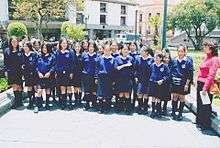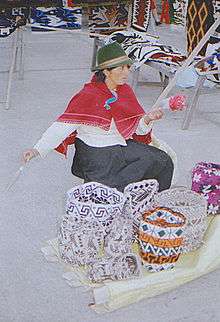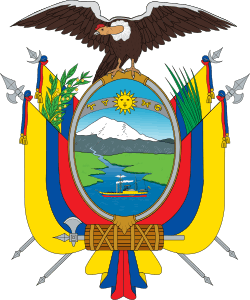Women in Ecuador
|
A portrait of a woman from Ecuador, 1867 | |
| Gender Inequality Index[1] | |
|---|---|
| Value | 0.429 (2013) |
| Rank | 82nd out of 152 |
| Maternal mortality (per 100,000) | 110 (2010) |
| Women in parliament | 38.7% (2013) |
| Females over 25 with secondary education | 40.1% (2012) |
| Women in labour force | 54.4% (2012) |
| Global Gender Gap Index[2] | |
| Value | 0.7389 (2013) |
| Rank | 25th out of 144 |
Women in Ecuador are generally responsible for the upbringing and care of children and families; traditionally, men have not taken an active role. Ever more women have been joining the workforce, which has resulted in men doing some housework, and becoming more involved in the care of their children. This change has been greatly influenced by Eloy Alfaro's liberal revolution in 1906, in which Ecuadorian women were granted the right to work. Women's suffrage was granted in 1929.
Girls tend to be more protected by their parents than boys, due to traditional social structures. At age 15, girls often have traditional parties called fiesta de quince años. Quinceañera is the term used for the girl, not the party. The party involves festive food and dance. This coming of age or debutante party is a tradition found in most Latin American countries, comparable to the American tradition of sweet sixteen parties.
Ecuadorian women continue for face many problems, including domestic violence, poverty and lack of proper access to healthcare.
Poverty
Women, especially rural women, are disproportionately affected by poverty. Women are more likely to be unemployed.[3] Poverty and malnutrition are most likely to affect women, as well as young children and indigenous populations.[4][5] Discrimination based on ethnicity interacts with discrimination based on sex, resulting in very high levels of poverty for indigenous and black women.[6]
Education


Girls traditionally have been less likely to be formally educated than men. Traditional gender roles lead women towards 'female jobs', such as nursing and teaching, which are underpaid and underappreciated.[3] Women still have a lower literacy rate than men: as of 2011, the literacy rate was 90.2% female and 93.1% male.[7] In recent years, several programs have promoted education for the indigenous girls and women.[8]
Reproductive health
Poor information and access to contraceptive methods often lead to unwanted pregnancies, especially among teenage girls and young women.[3] The maternal mortality rate in Ecuador is 110 deaths/100,000 live births (as of 2010).[9] The HIV/AIDS rate is 0.6% for adults (aged 15-49), as of 2012 estimates.[10] Abortion in Ecuador is illegal, with only few exceptions for special circumstances. According to a Human Rights Watch report, legal abortion is usually denied to women, even in the case of rape.[11] In recent years, being confronted with the highest teenage pregnancy rate in South America, Ecuador has decided to liberalize its policy regarding contraception, including emergency contraception. [12]
Domestic violence
Domestic violence against women is a very serious problem.[3] La Ley Contra la Violencia a la Mujer y la Familia[13] (Law on Violence against Women and the Family) deals with domestic violence. A study was conducted with data from 2010 comparing woman;s wealth to domestic violence in Ecuador. They found that violence increased when the man was the only source of income, and saw no significant relationship when the woman had higher wealth than the man. [14] In addition, a new Criminal Code came into force in 2014, which also addresses domestic violence.[15]
See also
References
- ↑ "Table 4: Gender Inequality Index". United Nations Development Programme. Retrieved 7 November 2014.
- ↑ "The Global Gender Gap Report 2013" (PDF). World Economic Forum. pp. 12–13.
- 1 2 3 4 https://www.un.org/womenwatch/daw/Review/responses/ECUADOR-English.pdf
- ↑ "Ecuador - World Food Programme". www.wfp.org. Retrieved 16 April 2018.
- ↑ "Publications - International IDEA" (PDF). www.idea.int. Retrieved 16 April 2018.
- ↑ "Advancing Gender Equality: Promising Practices - Improved Capabilities and Resources - Ecuador". www.unwomen.org. Retrieved 16 April 2018.
- ↑ "The World Factbook — Central Intelligence Agency". www.cia.gov. Retrieved 16 April 2018.
- ↑ "BBC NEWS - In pictures - School for Ecuador indigenous women". news.bbc.co.uk. Retrieved 16 April 2018.
- ↑ "The World Factbook — Central Intelligence Agency". www.cia.gov. Retrieved 16 April 2018.
- ↑ "The World Factbook — Central Intelligence Agency". www.cia.gov. Retrieved 16 April 2018.
- ↑ https://www.hrw.org/sites/default/files/reports/ecuador0813_ForUpload_1.pdf
- ↑ "Q&A: Ecuador Guarantees Right to Free Emergency Contraception - Inter Press Service". www.ipsnews.net. Retrieved 16 April 2018.
- ↑ http://pdba.georgetown.edu/Security/citizensecurity/ecuador/leyes/leyviolenciamujer.pdf
- ↑ Oduro, Abena (2 April 2015). "Women's Wealth and Intimate Partner Violence: Insights from Ecuador and Ghana". Feminist Economics. 21: 1–29.
- ↑ http://www.asambleanacional.gob.ec/system/files/document.pdf
External links
| Wikimedia Commons has media related to Women of Ecuador. |
| Wikimedia Commons has media related to People of Ecuador. |

